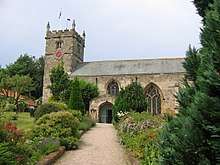Richard Osbaldeston (Attorney General)
Sir Richard Osbaldeston (c.1585 – 1640) was an English barrister who became Attorney General for Ireland. He was the great-grandfather of Richard Osbaldeston, Bishop of London.
Background and early career
He was born in Lancashire, probably at Sefton. His father Edward Osbaldeston (died 1639), belonged to an ancient Lancashire family, the Osbaldestons of Osbaldeston. Edward's father, the youngest son of a large family, made an advantageous marriage to Margaret Molyneux, daughter of Sir Richard Molyneux, 1st Baronet and Frances Gerard. Margaret's father was head of the family which later acquired the title Earl of Sefton, and her mother was a daughter of the prominent judge Sir Gilbert Gerard, Master of the Rolls.[1] They were also related to the Earl of Derby, and profited from this connection. By the 1620s the Osbaldestons were rich enough to buy the Manor of Hunmanby in Yorkshire, where they remained until the family died out in the 1830s.

Richard entered Gray's Inn and was called to the Bar. Few details of his career as a barrister survive but it is likely that he practiced in York, where he was living at the time of his first marriage in 1612.[2]
Attorney General
In 1636 he was knighted and sent to Ireland as the Irish Attorney General:[3] he already had a link with the Irish judiciary through his cousin Geoffrey Osbaldeston, Chief Justice of Connacht (died c.1635) who had a long if undistinguished record of service to the Crown.[4] Richard is said to have been a close associate of the Lord Deputy of Ireland, Thomas Wentworth, 1st Earl of Strafford, a fellow Yorkshireman, who may have known him in his younger days. Wentworth frequently consulted him on legal points,[5] but given the Lord Deputy's overwhelming personality and his almost total control of the Irish government, it is unlikely that any legal adviser had much influence over him.
Quo warranto campaign
It was Wentworth who in 1638 instructed Osbaldeston to bring proceedings for quo warranto (i.e. a claim that a person or public body is asserting a legal jurisdiction it does not possess) against those corporations in Munster which challenged the jurisdiction of the central Court of Admiralty; this was apparently at the request of Dr Alan Cooke, the Irish Admiralty judge.[6] In 1639 the quo warranto campaign was extended into an attack on all local landowners who claimed the right to hold local Admiralty courts. The campaign was not entirely successful: the Court of Exchequer (Ireland) ruled that Richard Talbot of Malahide Castle (ancestor of Baron Talbot de Malahide) had the right to hold an admiralty court for the port of Malahide in north Dublin.[7] The campaign seems to have petered out after Osbaldeston's death.[8]
Death
Probably Osbaldeston's most lasting memorial was the house he built adjacent to King's Inns.[9]
He died in Dublin in June 1640 and was buried in the Church of St. John the Evangelist, Dublin. Dr Cooke, the Admiralty judge, wrote to London with the terse message that "the old Attorney (General) is dead" and asking for a replacement to be sent quickly, to continue the quo warranto campaign.[10] Osbaldeston was replaced by Sir Thomas Tempest, but Strafford's impeachment, followed by the outbreak of the Irish Rebellion of 1641, soon made the effective conduct of government business impossible.
Family
He married firstly Eleanor Westropp, of Yorkshire, who died in 1638, and secondly Mary Nettleton of Thornhill, who outlived him. By his first marriage he had at least five children, but of these only William and Frances are known to have reached adult life. William was the grandfather of Richard Osbaldeston, Bishop of London.[11]
References
- Dugdale, William and Clay, John Visitations of Yorkshire W. Pollard and Co Exeter 1899
- Dugdale Visitations of Yorkshire
- Smyth, Constantine Chronicle of the Law Officers of Ireland Henry Butterworth London 1839
- Ball F. Elrington The Judges in Ireland 1221-1921 John Murray London 1926
- Cooper, J.P. The Fortune of Thomas Wentworth, Earl of Strafford (1958 ) Economic History Review Vol. 11 p.227
- Costello, Kevin The Court of Admiralty of Ireland 1575-1839 Four Courts Press Dublin 2011 p.25
- In the fifteenth century, both Henry VI and Edward IV had granted the title Admiral of the port of Malahide to Thomas Talbot.
- Costello pp.25-6
- Kenny, Colum The King's Inns and the Kingdom of Ireland Irish Academic Press Dublin 1992 p.116
- Costello p.25
- Dugdale Visitations of Yorkshire